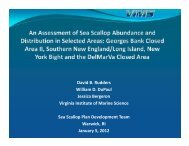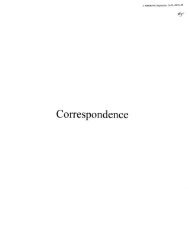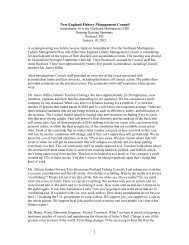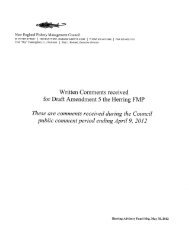Smooth Bottom Net Trawl Fishing Gear Effect on - New England ...
Smooth Bottom Net Trawl Fishing Gear Effect on - New England ...
Smooth Bottom Net Trawl Fishing Gear Effect on - New England ...
You also want an ePaper? Increase the reach of your titles
YUMPU automatically turns print PDFs into web optimized ePapers that Google loves.
NOAA/NMFS Unallied Science Project, Cooperative Agreement NA16FL2264 December 2005<br />
<str<strong>on</strong>g>Smooth</str<strong>on</strong>g> <str<strong>on</strong>g>Bottom</str<strong>on</strong>g> <str<strong>on</strong>g>Net</str<strong>on</strong>g> <str<strong>on</strong>g>Trawl</str<strong>on</strong>g> <str<strong>on</strong>g>Fishing</str<strong>on</strong>g> <str<strong>on</strong>g>Gear</str<strong>on</strong>g> <str<strong>on</strong>g>Effect</str<strong>on</strong>g> <strong>on</strong> the Seabed:<br />
Investigati<strong>on</strong> of Temporal and Cumulative <str<strong>on</strong>g>Effect</str<strong>on</strong>g>s BKAM/CR<br />
sufficiently str<strong>on</strong>g to produced bed-load transport of medium to fine sand. In additi<strong>on</strong>,<br />
the ROV video shows high levels of suspended fine-grained sediment. The source of this<br />
likely to be resuspended organic-mineral aggregates producing a near-bottom turbidity<br />
z<strong>on</strong>e. Such benthic turbidity z<strong>on</strong>es (BTZs) are known to be driven by tidal turbulence<br />
and are characterized by high ambient resuspensi<strong>on</strong> rates (Rhoads, et al., 1984). It is<br />
likely therefore that the impact <strong>on</strong> the bottom by the trawl’s ground cables /net sweep is<br />
comparable to natural seabed disturbance induced by sediment bed load transport of sand<br />
and tidal resuspensi<strong>on</strong> of fine fracti<strong>on</strong>s.<br />
Because we believe that n<strong>on</strong>e of the REMOTS® images were located within the trawl<br />
door tracks as observed in side scan and ROV images, the questi<strong>on</strong> remains as to the<br />
impact of this more extreme disturbance <strong>on</strong> the benthic fauna. Although door furrows<br />
associated with a single trawl pass are <strong>on</strong>ly approximately 1-2% of the total trawl<br />
footprint, this does not necessarily mean that the overall cumulative impact is<br />
ecologically trivial. For example, furrows and depressi<strong>on</strong>s are known to focus foraging<br />
search patterns by certain benthic or demersal c<strong>on</strong>sumers al<strong>on</strong>g these topographic<br />
features (Burrows, et al. 2003).<br />
3.5.4.3 Results of European trawl impact studies using SPI technology<br />
Insight into the effects of trawl door furrows <strong>on</strong> the benthic envir<strong>on</strong>ment, while not<br />
addressed in our Massachusetts Bay REMOTS® survey, can be provided by European<br />
studies <strong>on</strong> bottom trawl effects using the same profile imaging technology (REMOTS®<br />
sediment profile imaging used in this study is a registered trademark owned by SAIC.<br />
This same technique used by other entities is generically called sediment-profile imaging<br />
or SPI).<br />
Three SPI surveys of experimentally trawled bottom areas in Europe provide a basis of<br />
comparis<strong>on</strong> with the results of our Massachusetts Bay study: The Gullmarfjiord in<br />
Western Sweden, The Gulf of Li<strong>on</strong>s off the Rhône River mouth, and the Gulf of Irakli<strong>on</strong><br />
in the Aegean Sea <strong>on</strong> the north coast of Crete.<br />
The Gullmarfjiord study is particularly interesting as it was d<strong>on</strong>e after the study area was<br />
protected from shrimp trawling for 6 years. This hiatus provided an excellent baseline<br />
for comparis<strong>on</strong> with experimental trawling impacts (Nilss<strong>on</strong> and Rosenberg, 2003). The<br />
experimental area was randomly subdivided into three c<strong>on</strong>trol and 3 trawling transects;<br />
each ca. 1.5 km l<strong>on</strong>g. The bottom mud was located in water depths of 75 to 100 m. All<br />
transects were sampled three times in 1996 prior to trawling and three times in 1997 after<br />
trawling. Ten (10) replicated SPI images were randomly taken at each sampling event.<br />
<str<strong>on</strong>g>Trawl</str<strong>on</strong>g>ing was d<strong>on</strong>e using 80 x 140 cm (125 kg) trawl doors with a 14 meter-l<strong>on</strong>g (20 kg)<br />
ground rope. A distance of 30 meters separated the trawl doors.<br />
In this study, forty-three percent (43%) of the SPI images showed recognizable<br />
mechanical disturbance including trawl door furrows, which were about 10 cm deep and<br />
30 to 60 cm wide. These same images showed a decrease in a Benthic Habitat Quality<br />
(BHQ) index relative to c<strong>on</strong>trol transects. The BHQ index, as developed by Nilss<strong>on</strong> and<br />
55







